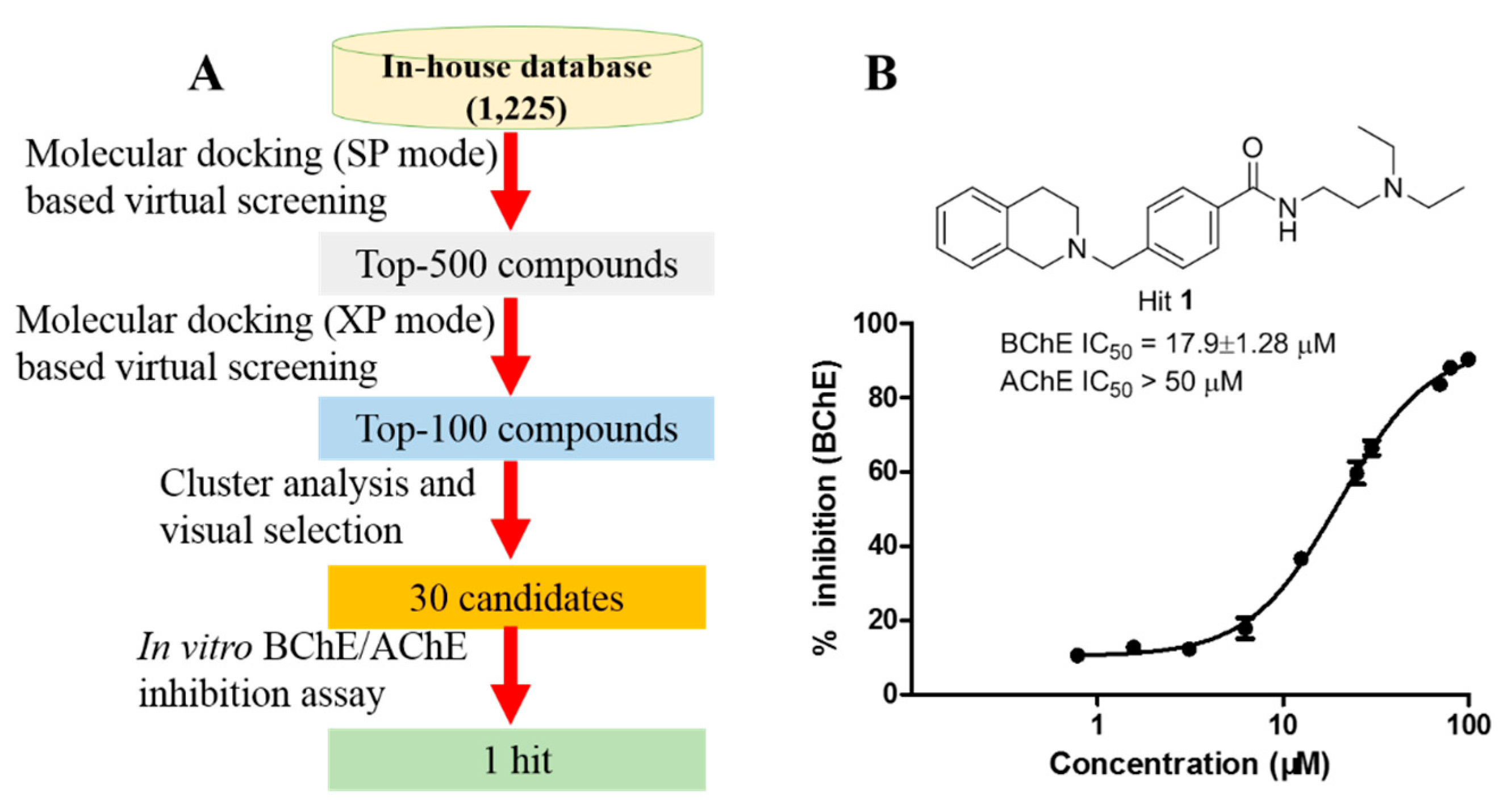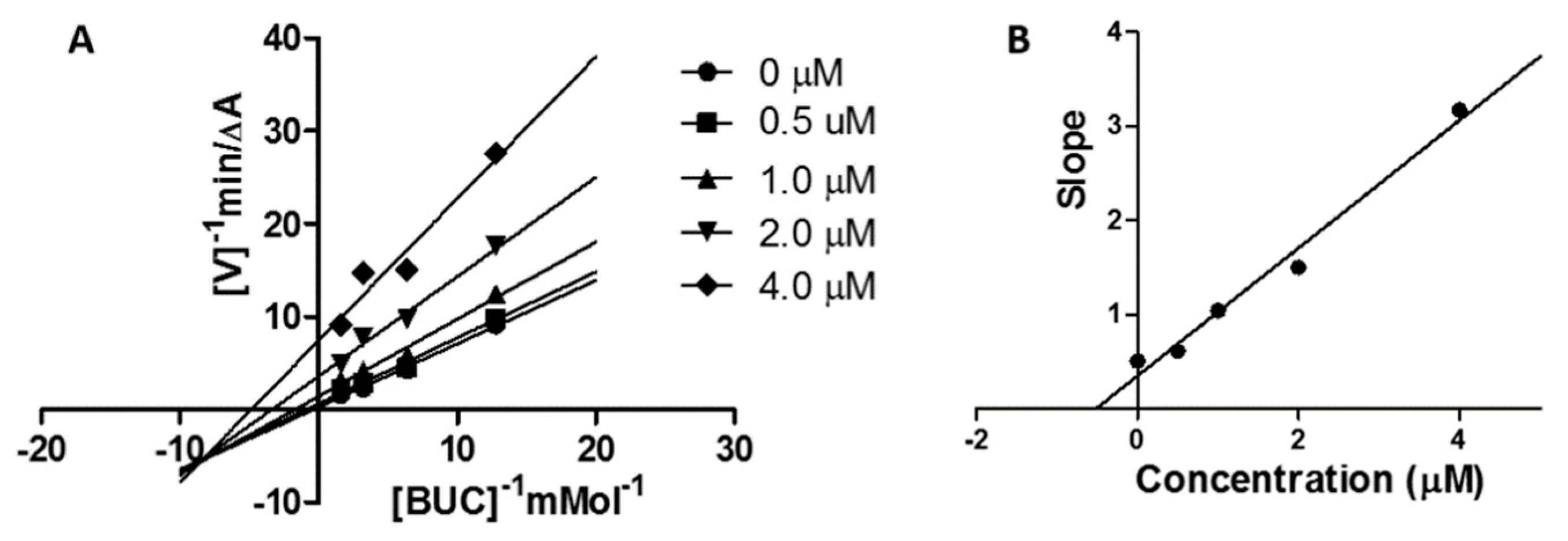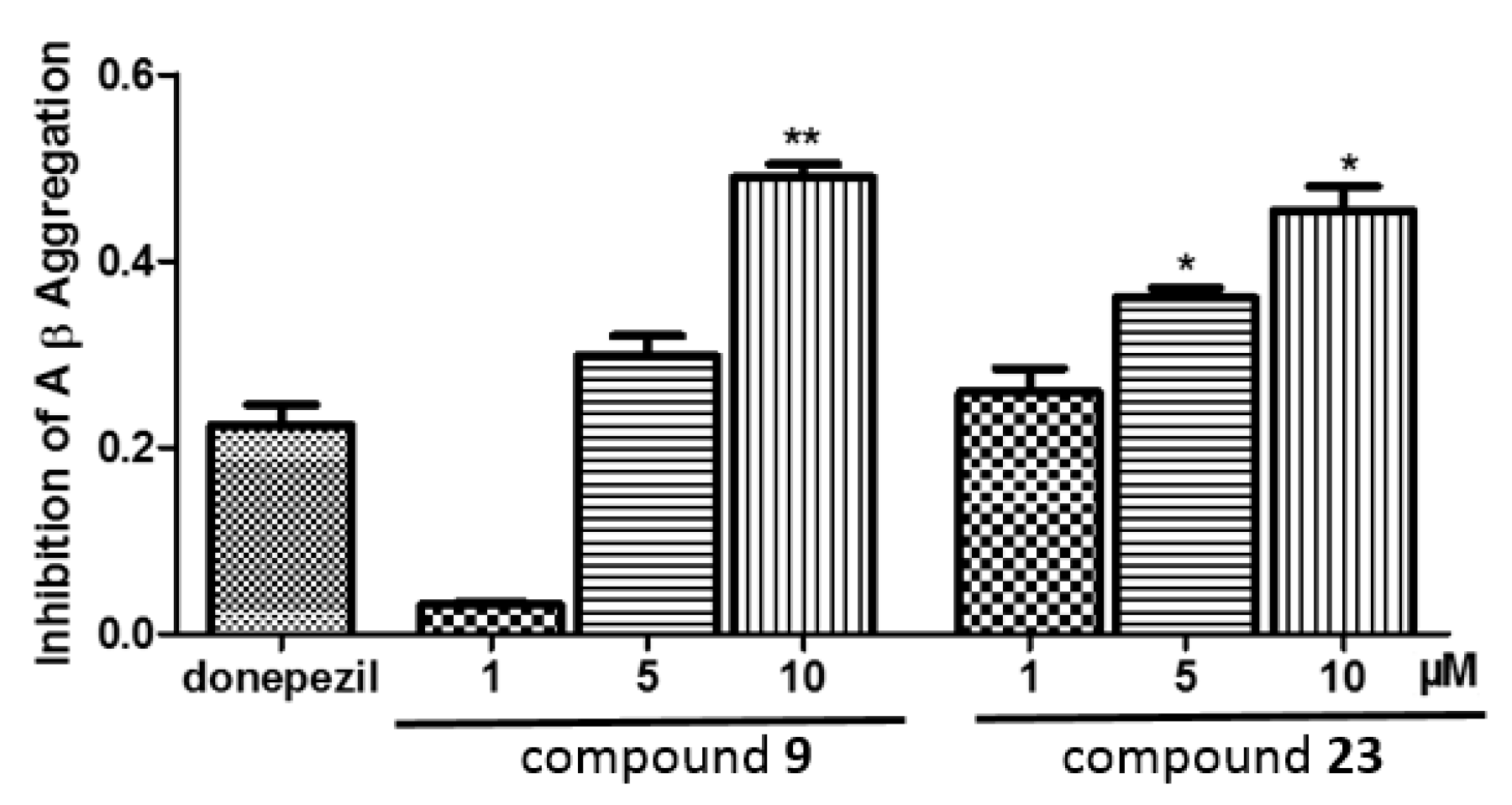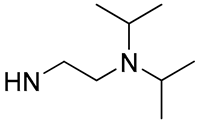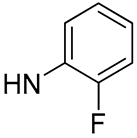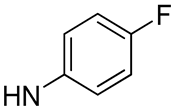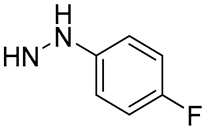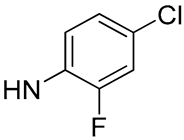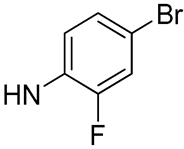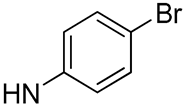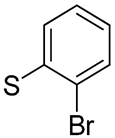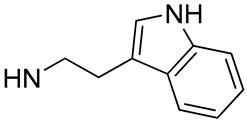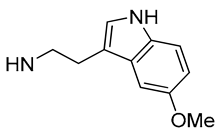3.2.3. General Procedure for the Synthesis of 1–30
The intermediates B (0.374 mmol, 1 equiv.) were dissolved in 5 mL DMF in a vial. 2-(7-azabenzotriazol-1-yl)-N,N,N’,N’-tetramethyluronium hexafluorophosphate (HATU) (156.4 mg, 0.411 mmol, 1.1 equiv.) were added to the reaction mixture. A series of corresponding amines or others ((4-fluorophenyl)hydrazine, 2-bromophenol and 2-bromobenzenethiol) (0.374 mmol, 1 equiv.) and DIPEA (193.3 mg, 1.496 mmol, 4 equiv.) were made in a separate vial. This solution was added to the reaction mixture drop wise and the reaction mixture was stirred overnight at room temperature. Upon completion of the reaction as detected by TLC, water (10 mL) was added and the product was extracted with EtOAc (3 × 10 mL). The combined organic layers were dried using MgSO4, then concentrated under vacuum, and the residues were purified by flash chromatography using PE:EtOAc = 2:1 as an eluent to give the target compounds 1–30.
N-(2-(diethylamino)ethyl)-4-((3,4-dihydroisoquinolin-2(1H)-yl)methyl)benzamide (1). Yellow oil (yield 62.5%). 1H-NMR (600 MHz, DMSO-d6) δ 8.34 (t, J = 5.8 Hz, 1H), 7.80 (d, J = 8.2 Hz, 2H), 7.44 (d, J = 8.2 Hz, 2H), 7.13-7.06 (m, 3H), 6.99 (d, J = 7.3 Hz, 1H), 3.69 (s, 2H), 3.53 (s, 2H), 3.32-3.29 (m, 2H), 2.81 (t, J = 5.8 Hz, 2H), 2.67 (t, J = 5.8 Hz, 2H), 2.57-2.50 (m, 6H), 0.97 (t, J = 7.1 Hz, 6H). 13C-NMR (150 MHz, DMSO-d6) δ 165.9, 141.7, 134.7, 134.1, 133.4, 128.5, 127.1, 126.3, 126.0, 125.5, 61.4, 55.4, 51.5, 50.3, 46.8, 39.5, 37.5, 28.7, 11.9. ESI-MS m/z 366.2 [M + H]+. HR-ESIMS: [M + H]+ calcd for C23H32N3O+ 366.2545, found 366.2549.
4-((3,4-dihydroisoquinolin-2(1H)-yl)methyl)-N-(2-(diisopropylamino)ethyl)benzamide (2). Yellow oil (yield 54.7%). 1H-NMR (600 MHz, DMSO-d6) δ 8.34 (t, J = 5.8 Hz, 1H), 7.81 (d, J = 8.2 Hz, 2H), 7.44 (d, J = 8.2 Hz, 2H), 7.12-7.06 (m, 3H), 6.99 (d, J = 7.3 Hz, 1H), 3.69 (s, 2H), 3.53 (s, 2H), 3.21-3.17 (m, 2H), 3.00-2.94 (m, 2H), 2.81 (t, J = 5.8 Hz, 2H), 2.67 (t, J = 5.8 Hz, 2H), 2.53-2.50 (m, 2H), 0.98 (d, J = 6.6 Hz, 12H). 13C-NMR (150 MHz, DMSO-d6) δ 165.8, 141.6, 134.7, 134.0, 133.4, 128.5, 127.1, 126.3, 126.0, 125.5, 61.4, 55.4, 50.3, 48.5, 44.2, 41.0, 39.5, 28.7, 20.7. ESI-MS m/z 394.2 [M + H]+. HR-ESIMS: [M + H]+ calcd for C25H36N3O+ 394.2858, found 394.2853.
4-((3,4-dihydroisoquinolin-2(1H)-yl)methyl)-N-(2-(dimethylamino)ethyl)benzamide (3). Yellow solid (yield 55.5%). 1H-NMR (600 MHz, DMSO-d6) δ 8.35 (t, J = 5.7 Hz, 1H), 7.81 (d, J = 8.2 Hz, 2H), 7.44 (d, J = 8.2 Hz, 2H), 7.13-7.06 (m, 3H), 6.99 (d, J = 7.3 Hz, 1H), 3.69 (s, 2H), 3.53 (s, 2H), 2.81 (t, J = 5.8 Hz, 2H), 2.67 (t, J = 5.8 Hz, 2H), 2.50 (d, J = 1.8 Hz, 1H), 2.50 (d, J = 1.8 Hz, 1H), 2.41 (t, J = 6.8 Hz, 2H), 2.19 (s, 6H). 13C-NMR (150 MHz, DMSO-d6) δ 166.0, 141.7, 134.7, 134.1, 133.3, 128.5, 127.2, 126.4, 126.0, 125.5, 61.4, 58.2, 55.4, 50.3, 45.2, 39.5, 37.3, 28.7. ESI-MS m/z 338.2 [M + H]+. HR-ESIMS: [M + H]+ calcd for C21H28N3O+ 338.2232, found 338.2236.
4-((3,4-dihydroisoquinolin-2(1H)-yl)methyl)-N-(2-(ethylamino)ethyl)benzamide (4). Yellow solid (yield 60%). 1H-NMR (600 MHz, DMSO-d6) δ 8.39 (t, J = 5.6 Hz, 1H), 7.82 (d, J = 8.2 Hz, 2H), 7.43 (d, J = 8.2 Hz, 2H), 7.13-7.06 (m, 3H), 6.99 (d, J = 7.3 Hz, 1H), 3.69 (s, 2H), 3.53 (s, 2H), 2.81 (t, J = 5.8 Hz, 2H), 2.69-2.65 (m, 4H), 2.56 (q, J = 7.1 Hz, 2H), 2.50 (d, J = 1.8 Hz, 2H), 2.50 (d, J = 1.8 Hz, 1H), 1.01 (t, J = 7.1 Hz, 3H). 13C-NMR (150 MHz, DMSO-d6) δ 166.1, 141.7, 134.7, 134.1, 133.4, 128.5, 128.4, 127.2, 126.4, 126.0, 125.5, 61.4, 55.4, 50.3, 48.5, 43.3, 39.5, 28.7, 15.1. ESI-MS m/z 338.2 [M + H]+. HR-ESIMS: [M + H]+ calcd for C21H28N3O+ 338.2232, found 338.2213.
4-((3,4-dihydroisoquinolin-2(1H)-yl)methyl)-N-(2,2-dimethoxyethyl)benzamide (5). Yellow oil (yield 64.3%). 1H-NMR (600 MHz, DMSO-d6) δ 8.52 ((t, J = 5.8 Hz, 1H), 7.84 (d, J = 8.2 Hz, 2H), 7.45 (d, J = 8.2 Hz, 2H), 7.13-7.05 (m, 3H), 6.99 (d, J = 7.3 Hz, 1H), 4.52 (t, J = 5.5 Hz, 1H), 3.69 (s, 2H), 3.53 (s, 2H), 3.38-3.32 (m, 6H), 2.81 (t, J = 5.8 Hz, 2H), 2.69-2.65 (m, 2H). 13C-NMR (150 MHz, DMSO-d6) δ 166.2, 141.9, 134.7, 134.1, 133.0, 128.5, 128.5, 127.3, 126.4, 126.0, 125.5, 101.9, 61.4, 55.4, 53.2, 53.2, 50.3, 41.1, 39.5, 28.7. ESI-MS m/z 355.1 [M + H]+. HR-ESIMS: [M + H]+ calcd for C21H27N2O3+ 355.2022, found 355.2026.
4-((3,4-dihydroisoquinolin-2(1H)-yl)methyl)-N-(2-morpholinoethyl)benzamide (6). Yellow solid (yield 57%). 1H-NMR (600 MHz, DMSO-d6) δ 8.37 (t, J = 5.6 Hz, 1H), 7.80 (d, J = 8.2 Hz, 2H), 7.44 (d, J = 8.2 Hz, 2H), 7.13-7.04 (m, 3H), 6.99 (d, J = 7.3 Hz, 1H), 3.69 (s, 2H), 3.57 (t, J = 4.5 Hz, 4H), 3.53 (s, 2H), 3.38 (q, J = 6.6 Hz, 2H), 2.81 (t, J = 5.8 Hz, 2H), 2.67 (t, J = 5.8 Hz, 2H), 2.50 (s, 1H), 2.46 (t, J = 6.9 Hz, 2H), 2.41 (s, 3H). 13C-NMR (150 MHz, DMSO-d6) δ 166.0, 141.8, 134.7, 134.1, 133.3, 128.5, 128.5, 127.2, 126.4, 126.0, 125.5, 66.2, 61.4, 57.4, 55.4, 53.3, 50.3, 39.5, 36.5, 28.7. ESI-MS m/z 380.2 [M + H]+. HR-ESIMS: [M + H]+ calcd for C23H30N3O2+ 380.2338, found 380.2330.
4-((3,4-dihydroisoquinolin-2(1H)-yl)methyl)-N-(2-(pyrrolidin-1-yl)ethyl)benzamide (7). White solid (yield 60%). 1H-NMR (600 MHz, DMSO-d6) δ 8.39 (t, J = 5.6 Hz, 1H), 7.81 (d, J = 8.2 Hz, 2H), 7.44 (d, J = 8.2 Hz, 2H), 7.13-7.06 (m, 3H), 6.99 (d, J = 7.3 Hz, 1H), 3.69 (s, 2H), 3.53 (s, 2H), 3.37 (q, J = 6.8 Hz, 2H), 2.81 (t, J = 5.8 Hz, 2H), 2.67 (t, J = 5.8 Hz, 2H), 2.56 (t, J = 7.0 Hz, 2H), 2.49-2.45 (m, 4H), 1.67 (p, J = 3.1 Hz, 4H). 13C-NMR (150 MHz, DMSO-d6) δ 165.9, 141.7, 134.7, 134.1, 133.3, 128.5, 127.2, 126.3, 126.0, 125.5, 61.4, 55.4, 54.9, 53.7, 50.3, 39.5, 38.6, 28.7, 23.1. ESI-MS m/z 337.1 [M + H]+. HR-ESIMS: [M + H]+ calcd for C23H30N3O+ 364.2389, found 364.2365.
4-((3,4-dihydroisoquinolin-2(1H)-yl)methyl)-N-((1-ethylpyrrolidin-2-yl)methyl)benzamide (8). Yellow oil (yield 74.5%). 1H-NMR (600 MHz, DMSO-d6) δ 8.34 (t, J = 5.7 Hz, 1H), 7.80 (d, J = 8.2 Hz, 2H), 7.44 (d, J = 8.2 Hz, 2H), 7.13-7.05 (m, 3H), 6.99 (d, J = 7.3 Hz, 1H), 3.69 (s, 2H), 3.53 (s, 2H), 3.43-3.38 (m, 1H), 3.08-3.00 (m, 2H), 2.87-2.82 (m, 1H), 2.81 (t, J = 5.8 Hz, 2H), 2.67 (t, J = 5.8 Hz, 2H), 2.57 (m, 1H), 2.27 (m, 1H), 2.15-2.08 (m, 1H), 1.77 (m, 1H), 1.67-1.55 (m, 3H), 1.04 (t, J = 7.2 Hz, 3H). 13C-NMR (150 MHz, DMSO-d6) δ 166.1, 141.7, 134.7, 134.1, 133.4, 128.5, 127.2, 126.3, 126.0, 125.5, 62.7, 61.4, 55.4, 53.3, 50.3, 48.2, 43.2, 39.5, 28.7, 28.6, 22.4, 13.9. ESI-MS m/z 378.2 [M + H]+. HR-ESIMS: [M + H]+ calcd for C24H32N3O+ 378.2545, found 378.2563.
(4-((3,4-dihydroisoquinolin-2(1H)-yl)methyl)phenyl)(pyrrolidin-1-yl)methanone (9). Yellow oil (yield 74%). 1H-NMR (600 MHz, DMSO-d6) δ 7.48 (d, J = 8.1 Hz, 2H), 7.41 (d, J = 8.1 Hz, 2H), 7.09 (m, 3H), 6.99 (d, J = 7.3 Hz, 1H), 3.67 (s, 2H), 3.54 (s, 2H), 3.48-3.39 (m, 4H), 2.81 (t, J = 5.8 Hz, 2H), 2.68 (t, J = 5.8 Hz, 2H), 1.88-1.83 (m, 2H), 1.82-1.77 (m, 2H). 13C-NMR (150 MHz, DMSO-d6) δ 168.2, 140.2, 135.9, 134.7, 134.1, 128.5, 128.4, 127.1, 126.4, 126.0, 125.5, 61.5, 55.4, 50.3, 49.0, 45.9, 39.5, 28.7, 26.0, 23.9. ESI-MS m/z 321.1 [M + H]+. HR-ESIMS: [M + H]+ calcd for C21H25N2O+ 321.1967, found 321.1997.
(4-((3,4-dihydroisoquinolin-2(1H)-yl)methyl)phenyl)(morpholino)methanone (10). Yellow oil (yield 68%). 1H-NMR (600 MHz, DMSO-d6) δ 7.43 (d, J = 8.1 Hz, 2H), 7.38 (d, J = 8.1 Hz, 2H), 7.13-7.06 (m, 3H), 7.00 (d, J = 7.2 Hz, 1H), 3.68 (s, 2H), 3.59 (s, 4H), 3.55 (s, 2H), 2.82 (t, J = 5.8 Hz, 2H), 2.68 (t, J = 5.8 Hz, 2H). 13C-NMR (150 MHz, DMSO-d6) δ 169.1, 140.1, 134.7, 134.2, 134.1, 128.6, 128.5, 127.1, 126.4, 126.0, 125.5, 66.1, 61.4, 55.4, 50.2, 39.5, 28.7. ESI-MS m/z 337.1 [M + H]+. HR-ESIMS: [M + H]+ calcd for C21H25N2O2+ 337.1916, found 337.1909.
(4-((6-bromo-3,4-dihydroisoquinolin-2(1H)-yl)methyl)phenyl)(pyrrolidin-1-yl)methanone (11). Yellow oil (yield 64%). 1H-NMR (600 MHz, DMSO-d6) δ 7.48 (d, J = 8.1 Hz, 2H), 7.40 (d, J = 8.1 Hz, 2H), 7.32 (d, J =2.1Hz, 1H), 7.26 (dd, J = 8.2, 2.1Hz, 1H), 6.99 (d, J = 8.2 Hz, 1H), 3.68 (s, 2H), 3.50 (s, 2H), 3.45 (t, J = 6.7 Hz, 2H), 3.38 (t, J = 6.7 Hz, 2H), 2.82 (t, J = 5.8 Hz, 2H), 2.66 (t, J = 5.8 Hz, 2H), 1.88-1.83 (m, 2H), 1.82-1.77 (m. 2H). 13C-NMR (150 MHz, DMSO-d6) δ 168.1, 140.0, 137.1, 135.9, 134.2, 131.0, 128.6, 128.4, 128.3, 127.1, 118.8, 61.2, 54.8, 49.7, 49.0, 45.9, 39.5, 28.4, 26.0, 23.9. ESI-MS m/z 399.0 [M + H]+. HR-ESIMS: [M + H]+ calcd for C21H24BrN2O+ 399.1072, found 399.1056.
(4-((7-bromo-3,4-dihydroisoquinolin-2(1H)-yl)methyl)phenyl)(pyrrolidin-1-yl)methanone (12). Yellow oil (yield 65%). 1H-NMR (600 MHz, DMSO-d6) δ 7.48 (d, J = 7.8 Hz, 2H), 7.40 (d, J = 7.8 Hz, 2H), 7.29 (d, J = 8.2 Hz, 1H), 7.25 (s, 1H), 7.07 (d, J = 8.2 Hz, 1H), 3.67 (s, 2H), 3.55 (s, 2H), 3.46 (t, J = 6.7 Hz, 2H), 3.39 (t, J = 6.7 Hz, 2H), 2.77 (t, J = 5.7 Hz, 2H), 2.67 (t, J = 5.7 Hz, 2H), 1.89-1.83 (m, 2H), 1.82-1.77 (m, 2H). 13C-NMR (150 MHz, DMSO-d6) δ 168.1, 140.0, 137.5, 135.9, 133.6, 130.7, 129.0, 128.8, 128.3, 127.1, 118.3, 61.1, 54.8, 49.8, 48.9, 45.9, 39.5, 28.1, 26.0, 23.9. ESI-MS m/z 399.0 [M + H]+. HR-ESIMS: [M + H]+ calcd for C21H24BrN2O+ 399.1072, found 399.1062.
(4-((6-methoxy-3,4-dihydroisoquinolin-2(1H)-yl)methyl)phenyl)(pyrrolidin-1-yl)methanone (13). Brown oil (yield 71%). 1H-NMR (600 MHz, DMSO-d6) δ 7.48 (d, J = 8.0 Hz, 2H), 7.40 (d, J = 8.0 Hz, 2H), 6.91 (d, J = 9.2 Hz, 1H), 6.67 (d, J = 6.6 Hz, 2H), 3.69 (s, 3H), 3.66 (s, 2H), 3.48-3.44 (m, 4H), 3.39 (t, J = 6.5 Hz, 2H), 2.79 (t, J = 5.8 Hz, 2H), 2.65 (t, J = 5.8 Hz, 2H), 1.88-1.83 (m, 2H), 1.82-1.77 (m, 2H). 13C-NMR (150 MHz, DMSO-d6) δ 168.1, 157.5, 140.2, 135.9, 135.2, 128.3, 127.3, 127.1, 126.8, 113.0, 111.9, 61.5, 54.9, 50.2, 48.9, 45.9, 39.5, 29.0, 26.0, 23.9. ESI-MS m/z 351.1 [M + H]+. HR-ESIMS: [M + H]+ calcd for C22H27N2O2+ 351.2073, found 351.2079.
(4-((6,7-dimethoxy-3,4-dihydroisoquinolin-2(1H)-yl)methyl)phenyl)(pyrrolidin-1-yl)methanone (14). Yellow oil (yield 60.3%). 1H-NMR (600 MHz, DMSO-d6) δ 7.48 (d, J = 8.0 Hz, 2H), 7.40 (d, J = 8.0 Hz, 2H), 6.66 (s, 1H), 6.58 (s, 1H), 3.69 (s, 3H), 3.66 (s, 5H), 3.46 (t, J = 6.9 Hz, 2H), 3.43 (s, 2H), 3.39 (t, J = 6.5 Hz, 2H), 2.73 (t, J = 5.6 Hz, 2H), 2.66 (t, J = 5.6 Hz, 2H), 1.88-1.84 (m, 2H), 1.82-1.77 (m, 2H). 13C-NMR (151 MHz, DMSO-d6) δ 168.1, 147.2, 146.9, 140.3, 135.9, 128.4, 127.1, 126.4, 125.7, 111.8, 109.9, 61.6, 55.5, 55.4, 55.0, 50.6, 49.0, 45.9, 28.3, 26.0, 23.9. ESI-MS m/z 381.1 [M + H]+. HR-ESIMS: [M + H]+ calcd for C23H29N2O3+ 381.2178, found 381.2170.
4-((3,4-dihydroisoquinolin-2(1H)-yl)methyl)-N-phenylbenzamide (15). White solid (yield 56%). 1H-NMR (600 MHz, DMSO-d6) δ 10.22 (brs, 1H, NH), 7.93 (d, J = 8.2 Hz, 2H), 7.77 (d, J = 7.6 Hz, 2H), 7.52 (d, J = 8.2 Hz, 2H), 7.37-7.32 (m, 2H), 7.14-7.06 (m, 4H), 7.01 (s, 1H), 3.73 (s, 2H), 3.56 (s, 2H), 2.83 (t, J = 5.9 Hz, 2H), 2.70 (t, J = 5.9 Hz, 2H). 13C-NMR (150 MHz, DMSO-d6) δ 165.5, 142.4, 139.2, 134.7, 134.1, 133.7, 128.6, 128.6, 128.5, 127.8, 126.4, 126.1, 125.5, 123.7, 120.4, 61.4, 55.5, 50.3, 39.5, 28.7. ESI-MS m/z 343.1 [M + H]+. HR-ESIMS: [M + H]+ calcd for C23H23N2O+ 343.1810, found 343.1827.
4-((3,4-dihydroisoquinolin-2(1H)-yl)methyl)-N-(2-fluorophenyl)benzamide (16a). Yellow oil (yield 37%). 1H-NMR (600 MHz, DMSO-d6) δ 10.09 (brs, 1H, NH), 7.96 (d, J = 8.2 Hz, 2H), 7.61-7.57 (m, 1H), 7.52 (d, J = 8.2 Hz, 2H), 7.32-7.25 (m, 2H), 7.24-7.2 (m, 1H), 7.15-7.06 (m, 3H), 7.01 (d, J = 7.3 Hz, 1H), 3.74 (s, 2H), 3.56 (s, 2H), 2.83 (t, J = 5.8 Hz, 2H), 2.70 (t, J = 5.8 Hz, 2H). 13C-NMR (150 MHz, DMSO-d6) δ 165.3, 156.7, 155.0, 142.7, 134.7, 134.1, 132.7, 128.6, 128.5, 127.9, 127.2, 126.4, 126.0, 125.5, 124.3, 124.3, 115.9, 115.8, 61.4, 55.4, 50.3, 39.5, 28.7. ESI-MS m/z 361.0 [M + H]+. HR-ESIMS: [M + H]+ calcd for C23H22FN2O+ 361.1716, found 361.1757.
4-((3,4-dihydroisoquinolin-2(1H)-yl)methyl)-N-(3-fluorophenyl)benzamide (17). Yellow oil (yield 71.6%). 1H-NMR (600 MHz, DMSO-d6) δ 10.40 (brs, 1H, NH), 7.93 (d, J = 8.2 Hz, 2H), 7.78-7.73 (m, 1H), 7.56 (dd, J = 8.1, 1.9 Hz, 1H), 7.53 (d, J = 8.1 Hz, 2H), 7.38 (q, J = 8.1 Hz, 1H), 7.13-7.07 (m, 3H), 7.00 (d, J = 7.2 Hz, 1H), 6.96-6.89 (m, 1H), 3.73 (s, 2H), 3.56 (s, 2H), 2.83 (t, J = 5.7 Hz, 2H), 2.71-2.68 (m, 2H). 13C-NMR (150 MHz, DMSO-d6) δ 165.7, 162.9, 161.3, 142.7, 141.1, 141.0, 134.7, 134.1, 133.4, 130.3, 130.2, 128.6, 128.5, 127.8, 126.4, 126.0, 125.5, 115.9, 115.9, 61.4, 55.5, 50.3, 39.5, 28.7. ESI-MS m/z 360.9 [M + H]+. HR-ESIMS: [M + H]+ calcd for C23H22FN2O+ 361.1716, found 361.1722.
4-((3,4-dihydroisoquinolin-2(1H)-yl)methyl)-N-(4-fluorophenyl)benzamide (18). White solid (yield 60%). 1H-NMR (600 MHz, DMSO-d6) δ 10.30 (brs, 1H, NH), 7.93 (d, J = 8.2 Hz, 2H), 7.79 (m, 2H), 7.52 (d, J = 8.2 Hz, 2H), 7.22–7.17 (m, 2H), 7.10 (m, 3H), 7.00 (d, J = 7.3 Hz, 1H), 3.73 (s, 2H), 3.56 (s, 2H), 2.83 (t, J = 5.8 Hz, 2H), 2.69 (t, J = 5.8 Hz, 2H). 13C-NMR (150 MHz, DMSO-d6) δ 165.4, 159.1, 157.5, 142.5, 135.6, 135.6, 134.7, 134.1, 133.6, 128.6, 128.5, 127.8, 126.4, 126.1, 125.6, 122.2, 122.1, 115.3, 115.2, 61.4, 55.5, 50.3, 39.5, 28.7. ESI-MS m/z 361.0 [M + H]+. HR-ESIMS: [M + H]+ calcd for C23H22FN2O+ 361.1716, found 361.1707.
4-((3,4-dihydroisoquinolin-2(1H)-yl)methyl)-N-(4-fluorobenzyl)benzamide (19). Yellow solid (yield 61.2%). 1H-NMR (600 MHz, DMSO-d6) δ 9.03 (t, J = 6.0 Hz, 1H), 7.87 (d, J = 8.3 Hz, 2H), 7.46 (d, J = 8.3 Hz, 2H), 7.40-7.31 (m, 2H), 7.17-7.13 (m, 2H), 7.12-7.05 (m, 3H), 6.99 (d, J = 7.3 Hz, 1H), 4.46 (d, J = 6.0 Hz, 2H), 3.69 (s, 2H), 3.54 (s, 2H), 2.81 (t, J = 5.8 Hz, 2H), 2.67 (t, J = 5.8 Hz, 2H). 13C-NMR (150 MHz, DMSO-d6) δ 166.1, 161.9, 160.3, 142.0, 135.9, 135.9, 134.7, 134.0, 133.0, 129.2, 129.2, 128.5, 128.5, 127.3, 126.3, 126.0, 125.5, 115.0, 114.9, 61.4, 55.4, 50.3, 41.9, 39.5, 28.7. ESI-MS m/z 375.1 [M + H]+. HR-ESIMS: [M + H]+ calcd for C24H24FN2O+ 375.1873, found 375.1890.
4-((3,4-dihydroisoquinolin-2(1H)-yl)methyl)-N2019-(4-fluorophenyl)benzohydrazide (20). Yellow solid (yield 50%). 1H-NMR (600 MHz, DMSO-d6) δ 10.39 (d, J = 3.0 Hz, 1H), 7.92 (d, J = 3.0 Hz, 1H), 7.90 (d, J = 8.1 Hz, 2H), 7.49 (d, J = 8.1 Hz, 2H), 7.16-7.05 (m, 3H), 7.00 (t, J = 8.3 Hz, 3H), 6.84-6.73 (m, 2H), 3.71 (s, 2H), 3.55 (s, 2H), 2.82 (t, J = 5.8 Hz, 2H), 2.69 (t, J = 5.8 Hz, 2H). 13C-NMR (150 MHz, DMSO-d6) δ 166.3, 156.7, 155.1, 146.2, 142.5, 134.7, 134.1, 131.7, 128.7, 128.5, 127.4, 126.4, 126.1, 125.6, 115.3, 115.2, 113.6, 113.5, 61.4, 55.5, 50.3, 39.5, 28.7. ESI-MS m/z 376.0 [M + H]+. HR-ESIMS: [M + H]+ calcd for C23H23FN3O+ 376.1825, found 376.1845.
N-(4-chloro-2-fluorophenyl)-4-((3,4-dihydroisoquinolin-2(1H)-yl)methyl)benzamide (21). Yellow oil (yield 34%). 1H-NMR (600 MHz, DMSO-d6) δ 8.71 (dd, J = 4.3, 1.2 Hz, 1H), 8.50 (dd, J = 8.3, 1.2 Hz, 1H), 7.92 (d, J = 8.3 Hz, 2H), 7.50 (d, J = 8.3 Hz, 2H), 7.49-7.47 (m, 1H), 7.13-7.07 (m, 3H), 7.00 (d, J = 7.3 Hz, 1H), 3.76 (s, 2H), 3.58 (s, 2H), 2.84 (t, J = 5.8 Hz, 2H), 2.73 (t, J = 5.8 Hz, 2H). 13C-NMR (150 MHz, DMSO-d6) δ 167.2, 150.7, 139.6, 134.6, 133.9, 129.6, 129.4, 128.8, 128.7, 128.5, 126.4, 126.1, 125.6, 120.5, 61.2, 55.3, 50.2, 39.5, 28.5. ESI-MS m/z 395.0 [M + H]+. HR-ESIMS: [M + H]+ calcd for C23H21ClFN2O+ 395.1326, found 395.1301.
N-(4-bromo-2-fluorophenyl)-4-((3,4-dihydroisoquinolin-2(1H)-yl)methyl)benzamide (22). White solid (yield 40%). 1H-NMR (600 MHz, DMSO-d6) δ 10.19 (brs, 1H, NH), 7.95 (d, J = 8.2 Hz, 2H), 7.66 (dd, J = 10.0, 2.1 Hz, 1H), 7.58 (t, J = 8.4 Hz, 1H), 7.52 (d, J = 8.2 Hz, 2H), 7.46-7.43 (m, 1H), 7.13-7.07 (m, 3H), 7.00 (d, J = 7.3 Hz, 1H), 3.73 (s, 2H), 3.56 (s, 2H), 2.83 (t, J = 5.8 Hz, 2H), 2.70 (t, J = 5.8 Hz, 2H). 13C-NMR (150 MHz, DMSO-d6) δ 165.3, 156.5, 154.8, 142.9, 134.7, 134.1, 132.4, 128.7, 128.5, 128.4, 128.0, 127.5, 126.4, 126.1, 125.6, 119.4, 119.2, 117.6, 117.6, 61.4, 55.5, 50.3, 39.5, 28.7. ESI-MS m/z 439.0 [M + H]+. HR-ESIMS: [M + H]+ calcd for C23H21BrFN2O+ 439.0821, found 439.0802.
N-(2-bromophenyl)-4-((3,4-dihydroisoquinolin-2(1H)-yl)methyl)benzamide (23). Yellow oil (yield 51%). 1H-NMR (600 MHz, DMSO-d6) δ 8.69 (dd, J = 4.4, 1.4 Hz, 1H), 8.48 (dd, J = 8.4, 1.4 Hz, 1H), 7.93 (d, J = 8.2 Hz, 2H), 7.50 (d, J = 8.2 Hz, 2H), 7.46 (dd, J = 8.4, 4.4 Hz, 1H), 7.14-7.07 (m, 3H), 7.01 (d, J = 7.3 Hz, 1H), 3.79 (s, 2H), 3.61 (s, 2H), 2.84 (t, J = 5.8 Hz, 2H), 2.75 (t, J = 5.8 Hz, 2H). 13C-NMR (150 MHz, DMSO-d6) δ 167.21, 150.59, 139.59, 134.60, 134.10, 133.79, 129.74, 129.39, 128.92, 128.61, 128.46, 126.38, 126.16, 125.58, 120.44, 61.10, 55.14, 50.19, 39.5, 28.35. ESI-MS m/z 421.0 [M + H]+. HR-ESIMS: [M + H]+ calcd for C23H22BrN2O+ 421.0916, found 421.0910.
N-(3-bromophenyl)-4-((3,4-dihydroisoquinolin-2(1H)-yl)methyl)benzamide (24). Yellow oil (yield 61.1%). 1H-NMR (600 MHz, DMSO-d6) δ 10.38 (brs, 1H, NH), 8.12 (d, J = 1.9 Hz, 1H), 7.95–7.92 (m, 2H), 7.76 (d, J = 7.9 Hz, 1H), 7.53 (d, J = 8.0 Hz, 2H), 7.31 (m, 2H), 7.13-7.07 (m, 3H), 7.00 (d, J = 7.2 Hz, 1H), 3.73 (s, 2H), 3.57 (s, 2H), 2.83 (t, J = 5.7 Hz, 2H), 2.70 (m, 2H). 13C-NMR (150 MHz, DMSO-d6) δ 165.7, 142.7, 140.9, 134.7, 134.1, 133.3, 130.6, 128.7, 128.6, 128.5, 127.8, 126.4, 126.2, 125.5, 122.5, 121.4, 119.0, 61.4, 55.5, 50.3, 39.5, 28.7. ESI-MS m/z 421.0 [M + H]+. HR-ESIMS: [M + H]+ calcd for C23H22BrN2O+ 421.0916, found 421.0915.
N-(4-bromophenyl)-4-((3,4-dihydroisoquinolin-2(1H)-yl)methyl)benzamide (25). White solid (yield 38%). 1H-NMR (600 MHz, DMSO-d6) δ 10.36 (brs, 1H, NH), 7.93 (d, J = 8.2 Hz, 2H), 7.80-7.73 (m, 2H), 7.53 (m, 4H), 7.14-7.07 (m, 3H), 7.00 (d, J = 7.3 Hz, 1H), 3.73 (s, 2H), 3.56 (s, 2H), 2.83 (t, J = 5.8 Hz, 2H), 2.69 (t, J = 5.8 Hz, 2H). 13C-NMR (150 MHz, DMSO-d6) δ 165.6, 142.6, 138.7, 134.7, 134.1, 133.5, 131.5, 128.7, 128.5, 127.8, 126.4, 126.1, 125.6, 122.2, 115.3, 61.4, 55.5, 50.3, 39.5, 28.7. ESI-MS m/z 421.0 [M + H]+. HR-ESIMS: [M + H]+ calcd for C23H22BrN2O+ 421.0916, found 421.0922.
2-bromophenyl 4-((3,4-dihydroisoquinolin-2(1H)-yl)methyl)benzoate (26). Yellow oil (yield 64%). 1H-NMR (600 MHz, DMSO-d6) δ 8.14 (d, J = 8.3 Hz, 2H), 7.78 (dd, J = 8.1, 1.5 Hz, 1H), 7.63 (d, J = 8.3 Hz, 2H), 7.52-7.49 (m, 1H), 7.46 (dd, J = 8.1, 1.5 Hz, 1H), 7.31-7.28 (m, 1H), 7.13-7.08 (m, 3H), 7.02 (d, J = 7.3 Hz, 1H), 3.78 (s, 2H), 3.58 (s, 2H), 2.84 (t, J = 5.8 Hz, 2H), 2.72 (t, J = 5.8 Hz, 2H). 13C-NMR (150 MHz, DMSO-d6) δ 163.6, 148.0, 145.7, 134.6, 134.0, 133.2, 130.1, 129.2, 128.5, 128.1, 127.0, 126.4, 126.0, 125.5, 124.5, 115.7, 61.3, 55.4, 50.3, 39.5, 28.7. ESI-MS m/z 422.0 [M + H]+. HR-ESIMS: [M + H]+ calcd for C23H21BrNO2+ 422.0756, found 422.0757.
S-(2-bromophenyl) 4-((3,4-dihydroisoquinolin-2(1H)-yl)methyl)benzothioate (27). Yellow oil (yield 61.3%). 1H-NMR (600 MHz, DMSO-d6) δ 7.99 (d, J = 8.3 Hz, 2H), 7.86 (dd, J = 7.9, 1.3 Hz, 1H), 7.71 (dd, J = 7.6, 1.7 Hz, 1H), 7.61 (d, J = 8.3 Hz, 2H), 7.54-7.51 (m, 1H), 7.49-7.46 (m, 1H), 7.13-7.07 (m, 3H), 7.01 (d, J = 7.3 Hz, 1H), 3.76 (s, 2H), 3.57 (s, 2H), 2.83 (t, J = 5.8 Hz, 2H), 2.70 (t, J = 5.8 Hz, 2H). 13C-NMR (150 MHz, DMSO-d6) δ 187.1, 145.9, 138.0, 134.6, 134.3, 134.0, 133.5, 132.1, 129.6, 129.4, 128.7, 128.5, 128.3, 127.4, 126.4, 126.0, 125.5, 61.2, 55.4, 50.3, 28.7. ESI-MS m/z 438.0 [M + H]+. HR-ESIMS: [M + H]+ calcd for C23H21BrNOS+ 438.0527, found 438.0557.
N-(2-(1H-indol-3-yl)ethyl)-4-((3,4-dihydroisoquinolin-2(1H)-yl)methyl)benzamide (28). 1H-NMR (600 MHz, DMSO-d6) δ 10.81 (brs, 1H, NH), 8.58 (t, J = 5.7 Hz, 1H), 7.83 (d, J = 8.2 Hz, 2H), 7.59 (d, J = 8.0 Hz, 1H), 7.44 (d, J = 8.2 Hz, 2H), 7.34 (d, J = 8.0 Hz, 1H), 7.18 (d, J = 2.2 Hz, 1H), 7.15-7.03 (m, 4H), 7.02-6.93 (m, 2H), 3.69 (s, 2H), 3.58-3.51 (m, 4H), 2.95 (t, J = 7.5 Hz, 2H), 2.82 (t, J = 5.8 Hz, 2H), 2.68 (t, J = 5.8 Hz, 2H). 13C-NMR (150 MHz, DMSO-d6) δ 166.0, 141.7, 136.3, 134.7, 134.1, 133.5, 128.5, 127.3, 127.2, 126.4, 126.0, 125.5, 122.6, 120.9, 118.3, 118.2, 111.9, 111.4, 61.4, 55.5, 50.3, 40.2, 39.5, 28.7, 25.2. ESI-MS m/z 410.1 [M + H]+. HR-ESIMS: [M + H]+ calcd for C27H28N3O+ 410.2232, found 410.2250.
4-((3,4-dihydroisoquinolin-2(1H)-yl)methyl)-N-(2-(5-methyl-1H-indol-3-yl)ethyl)benzamide (29). White solid (yield 63.2%). 1H-NMR (600 MHz, DMSO-d6) δ 10.67 (brs, 1H, NH), 8.57 (t, J = 5.6 Hz, 1H), 7.83 (d, J = 8.2 Hz, 2H), 7.44 (d, J = 8.2 Hz, 2H), 7.34 (s, 1H), 7.22 (d, J = 8.2 Hz, 1H), 7.16-7.04 (m, 4H), 6.99 (d, J = 7.2 Hz, 1H), 6.89 (dd, J = 8.2, 1.2 Hz, 1H), 3.69 (s, 2H), 3.53 (d, J = 7.8 Hz, 4H), 2.92 (t, J = 7.5 Hz, 2H), 2.82 (t, J = 5.8 Hz, 2H), 2.68 (t, J = 5.8 Hz, 2H), 2.35 (s, 3H). 13C-NMR (150 MHz, DMSO-d6) δ 166.0, 141.7, 134.7, 134.6, 134.1, 133.5, 128.5, 128.4, 127.6, 127.2, 126.5, 126.3, 126.0, 125.5, 122.7, 122.5, 118.0, 111.5, 111.1, 61.4, 55.4, 50.3, 40.4, 39.5, 28.7, 25.2, 21.3. ESI-MS m/z 424.2 [M + H]+. HR-ESIMS: [M + H]+ calcd for C28H30N3O+ 424.2389, found 424.2404.
4-((3,4-dihydroisoquinolin-2(1H)-yl)methyl)-N-(2-(5-methoxy-1H-indol-3-yl)ethyl)benzamide (30). White solid (yield 58%). 1H-NMR (600 MHz, DMSO-d6) δ 10.64 (brs, 1H, NH), 8.57 (t, J = 5.7 Hz, 1H), 7.83 (d, J = 8.3 Hz, 2H), 7.44 (d, J = 8.3 Hz, 2H), 7.22 (d, J = 8.8 Hz, 1H), 7.14 (d, J = 2.3 Hz, 1H), 7.13-7.06 (m, 3H), 7.05 (d, J = 2.3 Hz, 1H), 6.99 (d, J = 7.2 Hz, 1H), 6.71 (dd, J = 8.7, 2.4 Hz, 1H), 3.71 (s, 3H), 3.69 (s, 2H), 3.57–3.50 (m, 4H), 2.92 (t, J = 7.4 Hz, 2H), 2.82 (t, J = 5.8 Hz, 2H), 2.70–2.65 (m, 2H). 13C-NMR (150 MHz, DMSO-d6) δ 166.0, 153.0, 141.7, 134.7, 134.1, 133.5, 131.4, 128.5, 128.5, 127.7, 127.2, 126.4, 126.0, 125.5, 123.3, 112.0, 111.8, 111.1, 100.2, 61.4, 55.4, 55.3, 50.3, 48.6, 40.2, 39.5, 28.7, 25.2. ESI-MS m/z 440.2 [M + H]+. HR-ESIMS: [M + H]+ calcd for C28H30N3O2+ 440.2338, found 440.2324.
